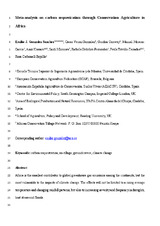Meta-analysis on carbon sequestration through Conservation Agriculture in Africa
Autor
González Sánchez, Emilio Jesús
Veroz-González, Óscar
Conway, Gordon
Moreno-García, Manuel
Kassam, Amir
Mkomwa, Saidi
Ordoñez-Fernández, Rafaela
Triviño Tarradas, Paula María
Carbonell-Bojollo, Rosa
Editor
ElsevierFecha
2019Materia
Carbon sequestrationNo-tillage
Groundcovers
Climate change
METS:
Mostrar el registro METSPREMIS:
Mostrar el registro PREMISMetadatos
Mostrar el registro completo del ítemResumen
Africa is the smallest contributor to global greenhouse gas emissions among the continents, but the most vulnerable to the impacts of climate change. The effects will not be limited to a rising average temperature and changing rainfall patterns, but also to increasing severity and frequency in droughts, heat stress and floods.
Agriculture is not only impacted upon by climate change but also contributes to global warming. However, not all agricultural systems affect negatively climate change. Conservation Agriculture (CA) is a farming system that promotes continuous no or minimum soil disturbance (i.e. no tillage), maintenance of a permanent soil mulch cover, and diversification of plant species. Through these principles it enhances biodiversity and natural biological processes above and below the ground surface, so contributing to increased water and nutrient use efficiency and productivity, to more resilient cropping systems, and to improved and sustained crop production. Conservation Agriculture is based on the practical application of three interlinked principles along with complementary good agricultural practice. The characteristics of CA make it one of the systems best able to contribute to climate change mitigation by reducing atmospheric greenhouse gas concentration.
In this article, the carbon sequestration potential of CA is assessed, both in annual and perennial crops, in the different agro-climatic regions of Africa. In total, the potential estimate of annual carbon sequestration in African agricultural soils through CA amounts to 143 Tg of C per year, that is 524 Tg of CO2 per year. This figure represents about 93 times the current sequestration figure.

